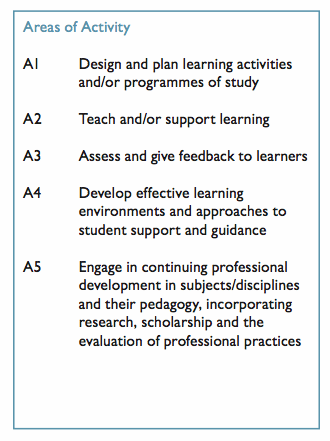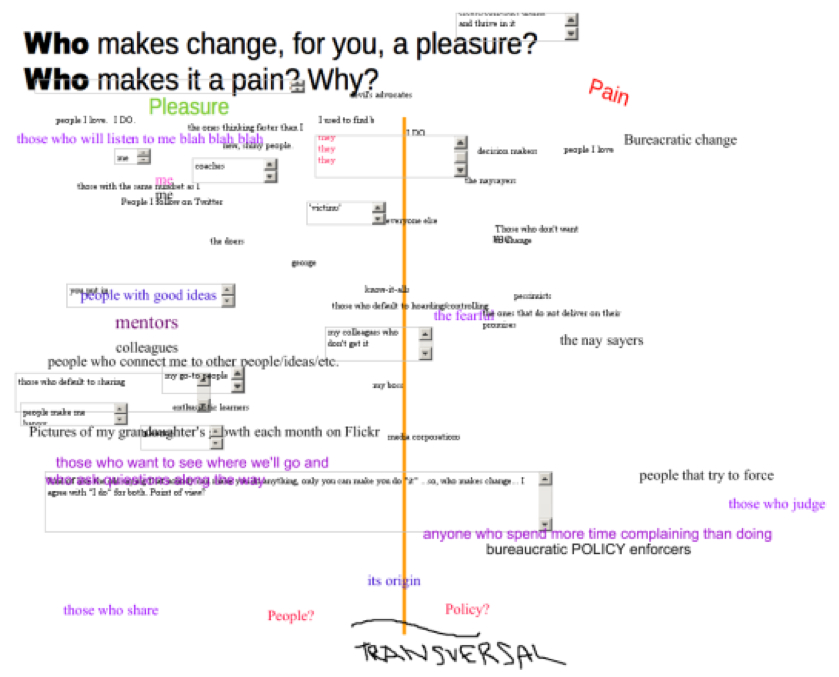[slideshare id=18416887&doc=usingtwitterforpersonalprofessionaldevelopment040213v9-130408121955-phpapp02]
Category: Learning & Teaching
How can I “Acknowledge the Opposite” when Preparing to Teach? #fslt12
 As I am putting the final tweaks in my preparation for my 3-hour on-campus session of my Pace University course, NURS 840: Teaching and Learning in Advanced Practice Nursing, I am again pausing for a moment to explore and further develop my COWIL model (Consider the Opposite of What I Like) to better meet the needs for my students. Students who like what I like or think similarly as I do are already fine — I will meet their learning needs more easily as we are already approaching learning in a similar manner. The trick is being able to meet the needs of other students who don’t approach teaching and learning as I do. Yes, I can focus on my methods that already seem to work, but is that really taking them where they are and working with them? Is that really respecting some of their own interests?
As I am putting the final tweaks in my preparation for my 3-hour on-campus session of my Pace University course, NURS 840: Teaching and Learning in Advanced Practice Nursing, I am again pausing for a moment to explore and further develop my COWIL model (Consider the Opposite of What I Like) to better meet the needs for my students. Students who like what I like or think similarly as I do are already fine — I will meet their learning needs more easily as we are already approaching learning in a similar manner. The trick is being able to meet the needs of other students who don’t approach teaching and learning as I do. Yes, I can focus on my methods that already seem to work, but is that really taking them where they are and working with them? Is that really respecting some of their own interests?
I cannot consider the opposite unless I am clearer on what I like. While I did enough of that to get me started on this process, I want to turn my reflective attention to considering what I do not like, or to put it more gently, to more clearly articulate what does not resonate as much with me. To do so, I will reach out again to borrow from the work of Stephen Brookfield, this time his work around around the critical thinking process:
- Identify assumptions embedded in words & actions (discourses & systems)
- Assess grounds – evidence, accuracy & validity
- Take alternative perspectives – intersubjective understanding / perspective taking
- Take informed action / agency
While I am not seeking to critically think through things at this time, I do want to focus on the assumptions aspect, namely to identify those things I assume — those taken for granted beliefs about the world, and our place within it, that seem so obvious to us as not to need to be stated explicitly (again, from Brookfield).
As I see my COWIL model developing, I intentionally want to identify the things I assume are not the case about the world and my place in it, in this context teaching and learning, and explore if there is some way I can bring those things into my class as UNDOUBTEDLY there will be people who think differently enough that perhaps their needs may be met.
Let’s try a simple example I have in mind. I assume people learn by discussing (constructionist) and also by internally grappling with content based on personal experience. However, this assumption does not readily allow for watching videos and then discussing them (as I personally do not watch a lot of television, videos, movies or the like). However, in Considering the Opposite of What I Like (COWIL), perhaps I should try a video or two (like we try all things in class to see if they work for the learners, content, time, etc.) in the course.
Yes, this is a simple example that may not need a degree in education to see, but what better place to start than with something simple as I am exploring and fleshing out this model? After all, if a video or something more multimedia does not work, what has been lost? If nothing else, it becomes another teachable moment as the experience (consider actor-network theory) may more closely resonate with common learning approaches for some.
I will let you know what I find, though working through COWIL from the critical thinking frame to flesh out those assumptions can be quite useful.
Using Reflective Practice to Plan for Friday’s Class (via #COWIL and #ANT for #fslt12)
 I have chosen to focus on the Areas of Activity Dimension of the Framework as part of my reflective practice:
I have chosen to focus on the Areas of Activity Dimension of the Framework as part of my reflective practice:
- A1 Design and plan learning activities and/or programmes of study
- A2 Teach and/or support learning
- A3 Assess and give feedback to learners
- A4 Develop effective learning environments and approaches to student support and guidance
- A5 Engage in continuing professional development in subjects/disciplines and their pedagogy, incorporating research, scholarship and the evaluation of professional practices
When I planned to use actor-network theory (ANT) in this reflective exercise, it was due in part to its focus on treating “everything in the social and natural worlds as a continuously generated effect of the webs of relations within which they are located” (pg. 1). In other words, thinking about my first on-campus session, we will all be there in a network of all our experiences, held in place at that time with all our technologies, artifacts, perspectives, likes and dislikes, etc.
What does that mean for my own preparation, especially in relationship to these Areas of Activity? Choosing only one of them to consider right now, such as “A3 Develop effective learning environments and approaches to student support and guidance,” I will now apply COWIL, which begins with my thinking about what I like.
Let’s see, in a class of adult learner degree students, I like discussion, open ended questions, answers that are not closed or limited, more questions than answers, and a certain discomfort in pushing new ideas. What don’t I like? Lecture, pretending to give all the answers, and students not reading the texts and preparing for the discussion ahead of time.
Hmm, ANT would also remind me about the other factors that will combine into Friday’s 3-hour class session, such as the food that will be provided, the room set-up, computer and other technologies in the room, unspoken student expectation, biases against the course topical area, questions about my own background, concerns about tuition payments, the air conditioning, etc.
What am I doing here? In considering how I will normally prepare for my class (the content, objectives, clarifications over assignments, and the like), it is easy to assume (or simply not even notice) the effect all these other factors bring to the room and help maintain the interaction of the experience together. How can I consider and give voice and experience to some of these other factors if I am going to focus on the effective learning environments and approaches to student support and guidance? Perhaps I can use a brief YouTube video or chart for some of the content (neither of which I want to do, but both of them may help learners capture some of the sense of the material and experience I want them to have). Perhaps we can address the food and air conditioning to see if they meet the needs? The room set-up can accommodate changing the tables and seats (as I just learned) if we change the classroom (something else I just learned is possible). While I don’t like lecture, perhaps I can model some of the way my own thinking has developed over my years of study of this content, something that will allow the content to be discussed without lecture (these are all bright DNP students; they can read and do not need lecture on this topic).
These are some of the things I am considering regarding the learning environment and approach to my first on-campus class in this blended course. I hope that including elements of the opposite of what I want (COWIL), along with some of the non-human elements of the expected learning (ANT) will help all of us in the course have a more engaging and open-ended experience that promotes more personal and critical learning.
Organizational Learning Challenges via Dilbert
I am a Nancy White Groupie
 I will confess to you, dear reader, that I am a Nancy White Groupie.
I will confess to you, dear reader, that I am a Nancy White Groupie.
No, I don’t follow her to see her on stage (who can keep up with that schedule, even to those places I cannot at times find on a map), nor do I toss my unmentionables (I have nothing that is unmentionable, BTW) to her across time and space for her benefit, though I would gladly share chocolate with her when I am able (or drinks when she visits New York). As a matter of fact, I have not even seen Nancy F2F for some years now (how she remains young while I grow older is the magic of memory and avatars, I suppose), though thinking of her always brings a smile to my face.
It is that smile that I want to consider.
I am not saying this because she had a screenshot of a Twitter conversation (yes, a real discussion, cf. Jenny and Jenny again) I had with John Mak (after an interesting exchange on his blog) during her #change11 MOOC session this past Monday (recording and slides etc. are here). I am saying this because she has a way of engaging people that gets creative juices flowing, even when it is about the most challenging of topics.
Take her session this past Monday. She asked us to consider change, especially related to creating a space for change. I was entirely engaged during the discussion, including the interactive whiteboarding she championed (see a screenshot to the right) that I watched without writing on. I could not write on this board because I was struggling with processing what she asked us to consider. I watched others. I was actively engaged in writing in and reading the chat stream (little surprise?) Because I like to think more than I like to draw. Because I believe reflecting on is an interactive and engaging activity. Even at the end of the session, I was not clear exactly what happened, what we (I) learned, nor what to do with it. Even here near the end of our week with Nancy, I struggle with her notion (or a notion she shared) about #socialartist. Even through some DM messages yesterday, somehow Nancy brought a positive spin to it. She didn’t leave me where I was–she encouraged and guided and urged me on, all with what I can only imagine being a smile on her face of knowing that we have to experience change ourselves–she can not tell us what will happen, but rather guide us to the edge and then steward us across.
Through all of this, Nancy makes me smile. I feel reassured and encouraged as she engages in online discussion and interactivity with a group spread across the globe. I don’t think it may matter to her how we react and engage; I think she cares more that we do react and engage. Perhaps in that variety of ways of approaching this lumbering issue of #change11 Education, Learning, and Technology, the issue is not so much about doing this or that right (as if there is a right way to experience education, learning, and technology), but that we move past our comfort zone, as only there will change (of the status quo) live.
Perhaps that is the (or a) point; change comes whether we want it or not, but if we engage in learning that pushes our boundaries while engaging in some aspect of community, the change may benefit from our shared exploration and thus be more fully realized. Borrowing from our actor-network theory colleagues, our learning network constantly changes, with technologies coming and going along with the people around them. This change really is the only constant. What can we do with all this change, especially so our voices get heard and we become part of it while not getting rolled over by it?
Ahh, that is what I think Nancy may really be getting at . . .
